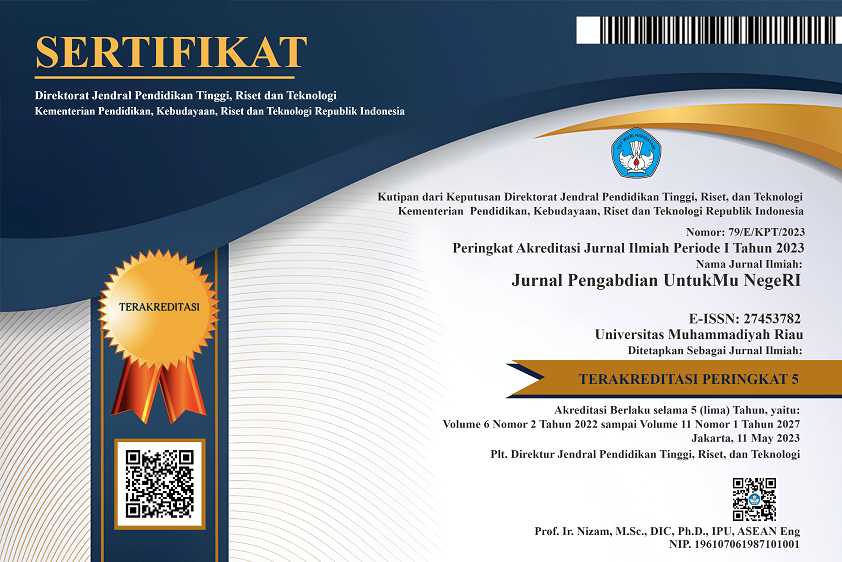Difusi Inovasi Melalui Pendampingan Mgmp Matematika Smp Dalam Pembuatan Video Virtualisasi Manipulatif Konkret Untuk Pembelajaran Jarak Jauh
DOI:
 https://doi.org/10.37859/jpumri.v5i2.3137
https://doi.org/10.37859/jpumri.v5i2.3137
Abstract
During the Covid-19 pandemic, teacher problems increased to maintain the effective implementation of mathematics learning. The available classical and individual concrete manipulative product innovations cannot be used in learning because learning policies during the pandemic still have to be carried out as distance learning. To overcome this problem, assistance was carried out in making videos of using concrete manipulatives to MGMP as concrete manipulative virtualization. The results of this activity show that there is an increase in the average score of the overall pre-self test competence to the post-self test. The same is true for each competency. In addition to producing video products on target, video quality is better, as well as increasing personal partners who act as actors and narrators. As a suggestion in this activity, mentoring continues to be carried out on an ongoing basis as a stage of diffusion of other innovation products and guidance for MGMP and partners of this activity can transmit to other MGMP member teachers.
Downloads
References
[2] N. Golafshani, “Teachers’ Beliefs and Teaching Mathematics with Manipulatives,” vol. 3, no. 2013, [Online]. Available: www.cje-rce.ca.
[3] L. Cope, “Math manipulatives: Making the abstract tangible,” Delta J. Educ., vol. 5, no. 1, pp. 10–19, 2015.
[4] H. Kontaş, “The Effect of Manipulatives on Mathematics Achievement and Attitudes of Secondary School Students,” J. Educ. Learn., vol. 5, no. 3, pp. 10–20, 2016, doi: https://doi.org/10.5539/jel.v5n3p10.
[5] A. Cockett, P. W. Kilgour, A. Cockett, and P. Kilgour, “Mathematical Manipulatives: Creating an Environment for Understanding, Efficiency, Engagement, and Enjoyment,” Teach Collect. Christ. Educ., vol. 1, no. 1, pp. 47–54, 2015.
[6] D. L. Ball, “Magical hopes: Manipulatives and The Reform of Math Education,” Am. Educ., pp. 14–20, 1992, [Online]. Available: https://eric.ed.gov/?id=EJ449539.
[7] E. Larbi and O. Mavis, “The use of Manipulatives in Mathematics Education,” J. Educ. Pract., vol. 7, no. 36, pp. 53–61, 2016.
[8] I. Hidayah, Dwijanto, and A. Istiandaru, “Manipulatives and Question Series for Elementary School Mathematics Teaching on Solid Geometry,” Int. J. Instr., vol. 11, no. 3, pp. 649–662, 2018.
[9] E. Apino and H. Retnawati, “Developing Instructional Design to Improve Mathematical Higher Order Thinking Skills of Students,” J. Phys. Conf. Ser. 812, vol. 812,
no. 1, p. 012100, 2017, doi: 10.1088/1742-6596/812/1/012100.
[10] S. R. Brady, J. A. Young, and D. A. McLeod, “Utilizing Digital Advocacy in Community Organizing: Lessons Learned from Organizing in Virtual Spaces to Promote Worker Rights and Economic Justice,” J. Community Pract., vol. 23, no. 2, pp. 255–273, 2015, doi: 10.1080/10705422.2015.1027803.
[11] I. Hidayah and Sugiarto, “Model of Independent Working Group of Teacher and its Effectiveness towards the Elementary School Teacher’s Ability in Conducting Mathematics Learning,” 2015.
[12] L. Navrátilová and F. Milichovský, “Ways of Using Guerrilla Marketing in SMEs,” Procedia - Soc. Behav. Sci., vol. 175, no. February, pp. 268–274, 2015, doi: 10.1016/j.sbspro.2015.01.1200.













